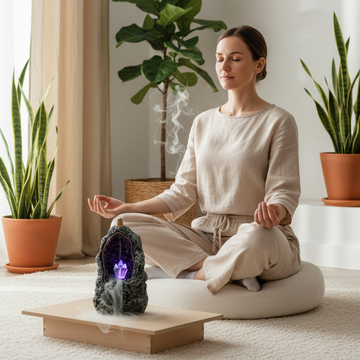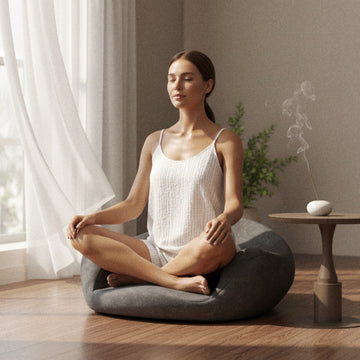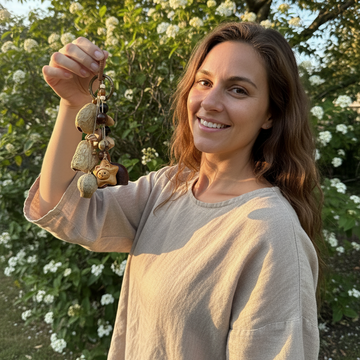
When we sit down for practice, there’s always an invisible threshold: how do we shift from daily noise into inner quiet? For many practitioners, a gentle whiff of incense is the key. It purifies the room, tugs the breath into rhythm, gathers attention, and lets focus arise naturally. In this article, we’ll blend story and hands-on instruction to help you understand four common burner types—and make smart choices for your space.
A Short Prelude About “Incense”
The first time I placed a backflow cone on a stone cascade, I simply watched the smoke slide downward like a slowed river. By the third breath, the inner chatter softened and the body found its own stable seat. Incense isn’t a perfume for the nose; it’s a “structure for entering the state”—repeatable, calibratable, memorable. Recreate it, and you can reliably return to calm.
The Four Burner Types: Strengths and Use Cases
1) Backflow Burner
-
Best for: Visual learners who benefit from a concrete “entry cue”; short sessions.
-
Typical setting: Desk or small meditation nook (80–160 sq ft / 8–15㎡).
-
Why it works: The smoke cascade is an excellent object of visualization.
-
Notes: Keep away from direct airflow; use low-smoke cones; align the cone’s hole with the draft channel.
2) Traditional Burner (Ash Bed / Mon-kō & Seal-incense)
-
Best for: Buddhist practice, morning/evening liturgy, formal offerings; also a reliable timekeeper.
-
Typical setting: Altar, living room practice corner, center/studio.
-
Why it works: Stable ember path and controllable smoke; seal-incense (zhuànxiāng) adds ritual beauty and intention.
-
Notes: Ash should be dry, sifted, and fluffy; after ignition, lightly cover the fire mouth so it smolders.
3) Stick Incense Burner (Lying or Upright)
-
Best for: Daily meditation, pre-sleep calming, restorative yoga.
-
Typical setting: Bedroom or study (50–130 sq ft / 5–12㎡).
-
Why it works: Easiest, most forgiving; one stick runs 15–30 minutes; quality natural sticks are gentle.
-
Notes: Prefer fine-gauge sticks; lying burners manage ash neatly; upright needs a stable base and clear ash-drop zone.
4) Temple-Style Burner (Tabletop or Courtyard)
-
Best for: Group sits, ceremonies, large-space cleansing.
-
Typical setting: Balcony, garden, hall.
-
Why it works: Long burn, broad coverage, maximum sense of ceremony.
-
Notes: Ventilation and fire safety first; outdoor use is ideal.
What to Choose for Different Scenarios
-
Small bedroom · pre-sleep (50–85 sq ft / 5–8㎡): Stick burner + sandalwood/soft floral blend (low smoke), 15–25 min, tiny window gap for air.
-
Study · deep focus (85–160 sq ft / 8–15㎡): Backflow burner + low-smoke agarwood cone, one 20-min sit; gaze at the cascade to enter.
-
Living-room altar · morning/evening practice: Traditional burner + blended/seal incense, 30–45 min; one seal pattern = one liturgy.
-
Yoga room · small group relax: Multiple stick points, 30–60 min, light and even distribution to avoid hot spots.
-
Balcony/garden · space cleansing: Temple burner + coil incense, 60–120 min, excellent airflow.
-
Hall/center · ceremonies: Temple burner + traditional ash bed, >60 min, prioritize ventilation and fire control.
From Lighting to Closing: A Smooth, Repeatable Workflow
-
Prep (3 minutes): Crack a window or run fresh-air briefly; tidy the altar/ash surface; take three settling breaths.
-
Ignition:
-
Backflow: Align cone hole to the draft channel; light for 2–3 seconds, blow to ember; watch 30–60 seconds for a stable cascade.
-
Traditional: Fluff the ash bed; for seal incense, press the pattern, fill with blend, ignite one end, lightly cover with ash.
-
Stick: On a lying tray, leave 5–8 mm from the head to the tray edge; for upright, fix the base and mind the ash-drop zone.
-
Temple: Prefer outdoors; once the ember path is steady, step back; keep a sand pan or extinguisher nearby.
-
-
During practice: Use the aroma as an attention anchor:
-
Breath counting (to ten; feel cool/warmth at the nostrils)
-
Visualization (backflow = arising/ceasing of thoughts; seal pattern = path of vows)
-
Chanting/recitation (incense as an unbroken condition)
-
-
Closing: Don’t pinch the ember; let it finish or cap with a snuffer. Lightly groom ash daily; sift every 1–2 weeks to remove char clumps.
Choosing Fragrances (Beginner-Friendly)
-
Agarwood/Sandalwood: Sweet-woody, grounding and steady—great for sitting and recitation.
-
Cypress/Pine: Clean and clarifying—ideal for mornings.
-
Frankincense/Myrrh: Clear resin tone—good for breath awareness and body–mind linking.
-
Floral blends: Even out moods in the evening.
-
Rule of thumb: Err on the lighter side; test half a stick first. Favor natural materials; avoid chemical fixatives and heavy dyes.
Safety & Health: Non-Negotiables
-
Ensure airflow but avoid direct drafts; keep 12 in / 30 cm from anything flammable.
-
With children/pets, use stable burners and a clear ash-drop area.
-
If you’re scent-sensitive, start with fine-gauge sticks + shorter durations.
-
If using charcoal, ignite outdoors, limit indoor use, and keep fire gear on hand.
A One-Week Practice Plan (Copy & Use)
-
Mon/Thu (AM): Stick • sandalwood 15–20 min, breath counting. (PM) Backflow • agarwood 15 min, cascade-gazing + counting.
-
Tue/Fri (AM): Stick • floral blend 20 min, body scan. (PM) Stick • sandalwood 20 min, loving-kindness.
-
Wed (AM): Seal incense 30 min, recitation + dedication. (PM) Stick 10 min, pre-sleep calming.
-
Weekend: Outdoor coil/group sit; add cleaning, care, and reflection.
Tiny Fixes, Big Gains (FAQ)
Q: My backflow doesn’t “flow back.” Why?
A: Too much breeze, misaligned holes, or tar blocking the draft. Reduce airflow, align the cone, and clear the channel with a cotton swab.
Q: The scent feels heady.
A: Reduce dose, switch to natural materials, add gentle cross-ventilation. If sensitive to smoke, prioritize sticks.
Q: Seal incense keeps going out.
A: Powder packed too tight or fire mouth too exposed. Loosen the surface and lightly cover the ember with ash.
Shopping Shortlist (By Priority)
-
Stick burner + 1–2 natural fine-gauge stick scents (daily and pre-sleep mainstay)
-
Backflow burner + low-smoke cones (visual entry cue and contemplation object)
-
Traditional burner + ash + seal molds + blended powder (liturgy and ritual)
-
Large/courtyard temple burner + coils (group practice, outdoor cleansing)
-
Tools: Soft brush, lint-free cloth, snuffer/sand pan, desiccant
Closing: Make Incense Your “Reproducible Calm Button”
Great practice isn’t a one-time spectacle—it’s something you can repeat reliably. From today on, assign a specific incense and a trusty burner to each sit. Each time you light it, you’re not just burning fragrance—you’re lighting a path back inward.








